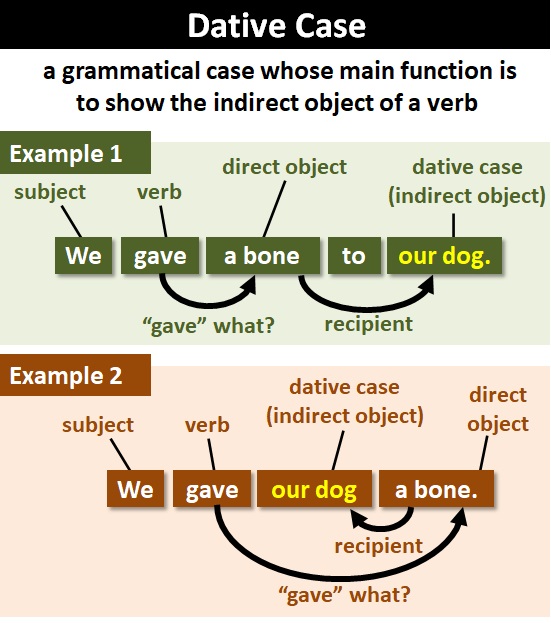


Take a look at these German dative examples in the following sentences from German Project and see how many you can identify the German dative in! Try using this term of the day in a sentence today! Below are a couple of examples of German datives from Your Dictionary that can help get you started incorporating this tool into your everyday use. Trying to use a word or grammatical technique in a sentence is one of the best ways to memorize what it is, but you can also try making flashcards or quizzes that test your knowledge. German datives can be used in many different contexts in the English language. The below list of translations of dative is provided by Word Sense. These are called cognates, which are words and forms in different languages that likely have the same root or language of origin, causing them to sound the same. You may notice that some of these translations of dative look and sound similar to one another. Many different languages also contain words that mean dative.

An, auf, hinter, in, neben, über, unter, vor, zwischen, entlang are also used with the dative case. There are the dative prepositions aus, außer, bei, mit, nach, seit, von, zu, gegenüber. First, the 9 common prepositions that are always dative. Strong declensions indicate the gender/case of the noun, while weak declensions do not. Declensions change based on the gender of the noun, which case it’s in, what type of words are in front of the noun, and how many of each type are in front of the noun. In German, when a noun is in the dative slot in a sentence, the determiner and/or adjective will take declensions, such as these instances of -m, -n, -s. Determiners include a, the, some, many, all, every, and so on that tell us how many or which one, while adjectives tell us the feature of a noun. The two types of rods that come in front of nouns are determiners and adjectives. In English, we can use the dative case or a prepositional phrase but in German, indirect objects are always put into the dative case. As with other cases like the nominative, the accusative case, and genitive, the dative case uses an indirect object to represent to or for whom action is taken. According to German with Laura, the dative case has a standard, basic function: signaling the indirect object of the sentence.


 0 kommentar(er)
0 kommentar(er)
